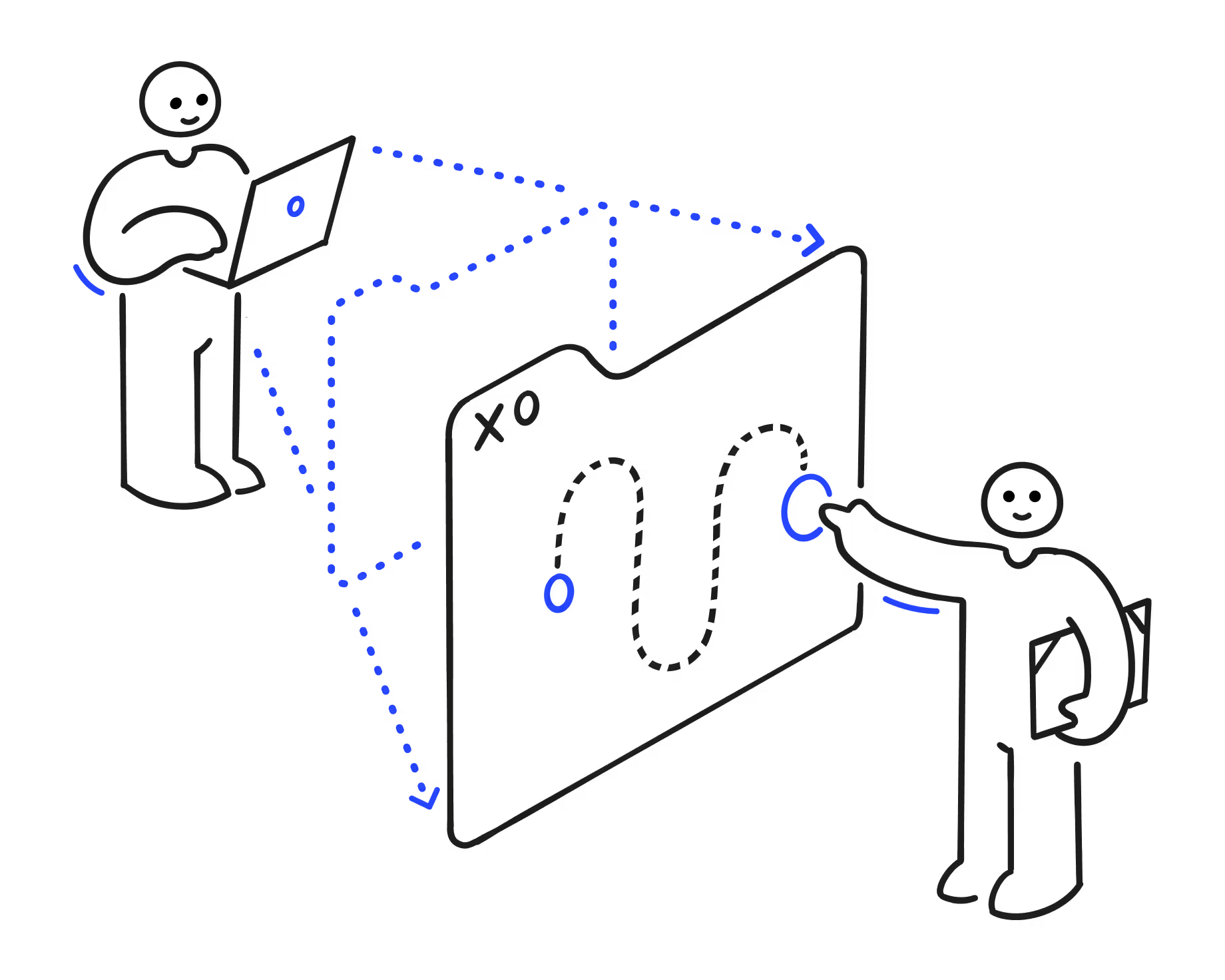How to communicate employee engagement survey results

Discover Workleap Officevibe's benchmark report on 12 key employee engagement metrics

If you value your employees and want them to feel engaged at work, you’re probably no stranger to surveys. And chances are you take that feedback seriously.
But collecting data is just the first step. The real impact comes when you share results openly and show how you’ll act on them.
Let’s look at how to communicate employee engagement survey results in a productive, improvement-focused way.
What’s an employee engagement survey?
An employee engagement survey is a way for workers to share how connected, supported, and motivated they feel at work. For leaders, it offers a real-time view of engagement levels. For employees, it shows that their voices matter. The goal is twofold: Gather insights that drive improvement and demonstrate that feedback leads to action.
Good engagement surveys reach every level of the organization, from leadership to frontline staff. Managers often run them, adding another layer of insight alongside performance reviews and everyday conversations.
Key metrics to track in employee engagement survey results
To get the most value, focus your survey questions on the following areas:
- Engagement score: Ask employees to rate how engaged they feel at work on a scale of one to 10. Define engagement so responses are accurate, and remember to leave space for open comments. Workleap Officevibe can help by automatically calculating engagement scores based on science-backed pulse surveys that measure engagement in 10 different areas.
- Job satisfaction: Measure how happy and motivated people feel in their role and whether they plan to stay. Pair ratings with open-text questions and stress confidentiality to encourage honesty and spot retention trends.
- Company culture: Invite employees to describe their cultural experience at the company. You can break this question into smaller ones, like “What do you enjoy most about coming to work?” and “What would you change about the company culture?”
- Growth opportunities: Ask about access to growth opportunities like training and learning programs, and ask what additional resources would support development.
- Communication: Learn how employees experience communication with peers and leadership. Their answers may show gaps in tools, processes, or dialogue.
- Diversity and inclusion: Ask employees to describe their experience with the company’s diversity and inclusion initiatives. Remind them they can express concerns safely and confidentially.
- Leadership: Learn how employees view company leadership. Pose survey questions on communication, feedback, recognition, and training styles.
- Work-life balance and well-being: Gauge employees' overall well-being to spot burnout risk. Are they happy with their benefits? Do they have enough time outside of work? What other support would help them achieve a good work-life balance?
How to prepare to communicate employee engagement survey results
Once you’ve collected data, analyze it and highlight the main insights. Then, share results using these approaches:
- Environment: Choose whether to present results in a live meeting or send a written summary with visuals that employees can look through at their own pace.
- Focus: Call out the big trends and focus areas. If many employees flag that communication with leadership feels unclear, tackle this concern. Don’t dwell on one-off comments that don’t reflect a bigger picture, and always connect tough feedback to clear actions.
- Transparency: Employees know what they said, so sweeping feedback under the rug only fuels doubt. Being upfront, even about challenges, helps build trust.
- Responses: Be ready to answer questions. Prepare for sensitive conversations about what isn’t working, and have clear, constructive answers about next steps.
- Commitments: You can’t fix everything overnight. Share what you can commit to now, along with realistic timelines. This clarity demonstrates how seriously you take their feedback.
Need help interpreting and presenting data? Workleap Officevibe gives managers instant, AI-powered insights and actionable recommendations to turn feedback into real progress.
Best practices for analyzing and sharing survey results for employee engagement
Surveys give you metrics to grow. The trick is knowing how to make the most of the results. Here are some best practices.
Interpreting challenging employee engagement survey results
You might not immediately have an “ah-ha moment” when reading data. Here’s how to interpret employee engagement survey results when answers aren’t ideal:
- Ambiguous answers: Don’t jump to conclusions when responses are unclear. Guesswork can lead to missteps and poor decisions. Instead, send a follow-up survey or hold small-group discussions to clarify muddled points.
- Identifying actionable insights: All employee feedback is useful, but not every comment calls for big changes. For example, one person may report that they’re unhappy with company culture, while most others just have good things to say. Treat this as an individual concern, acknowledging it and following up directly where you can.
- Big shifts: Say you aced company culture on last quarter’s survey, but it’s showing up as a huge issue this quarter. This kind of swing doesn’t just happen. Look for root causes that might explain sudden drops, like a leadership transition, new policies, or heavier workloads.
- Survey fatigue: Low response rates or shallow answers often mean people feel ignored. Keep feedback alive by closing the loop, sharing next steps, and sending fewer but sharper surveys.
Responding to employee engagement survey results
Level up your employee engagement survey communications with these tips:
- Acknowledgement: Employee engagement survey analysis starts with acknowledging the information. It may feel easier to sidestep areas that need improvement, but approaching them head-on builds reliability and trust. Pause to understand the results before generalizing or rushing into solutions.
- Look for root causes: Don’t stop at the surface. If employees say they lack work-life balance, dig deeper. Are deadlines too intense or schedules too rigid? Getting to the “why” makes your action plan sharper and your messaging stronger.
- Involve employees: Employees have given you the insights, so let them help shape the solutions. Leadership may think the fix for work stress is moving to a four-day work week, but employees may just want more realistic deadlines. Bringing them into the process makes sure the solutions you try address real needs.
- Develop targeted action plans: Broad fixes usually don’t stick. Instead, zero in on the themes that came up in the survey and outline clear steps, timelines, and owners. Focused actions show employees you’re serious about change while making progress easier to track.
4 effective staff survey result presentation methods
How you present survey results depends on factors like your organization's size and the audience you’re communicating results to. Here are four effective ways to tackle it.
1. All-hands meeting
If you’re at a smaller organization, bring everyone together for one presentation of the results. The benefit? You can run a live Q&A, giving employees space to react, ask questions, and talk things through in real time. Then, send a recap email with action items so nothing gets lost in the moment.
2. Departmental presentations
Break results down by team or function to keep the conversation focused. This way, department leaders can tailor insights to what matters most in their group and guide conversations on how to move forward.
3. Visual reports and infographics
No matter where you share results, use visuals to make data easier to understand. Charts and graphs will allow employees to see patterns clearly and connect the dots more quickly than they would by reading pages of text.
4. CEO video message
If you’re at a larger company, a recorded CEO video can bring the same energy as an all-hands. Stream it companywide, then follow up with team-level discussions to make the message more personal.
Key elements to include when reporting employee engagement survey results
Not sure what to include in your employee engagement survey report? Here are five sections that ensure clarity and impact.
Executive summary
Start with a snapshot of the main findings. This sets the tone for the rest of the report and makes it easy for employees and leaders to grasp the big takeaways. Wrap it up by stating how the company plans to respond to the top three insights.
Benchmark comparison
Context matters. Show how your results compare with industry benchmarks or past surveys so people can see where you’re excelling and where there’s room to grow.
Quantitative and qualitative feedback
Numbers tell one part of the story, but words bring it to life. Pair data points with direct quotes or comments from employees to capture both measurable outcomes and lived experiences.
Action plans
The leading cause of survey fatigue is employees feeling that nothing happens with their feedback. Spell out the goals and timelines so they can see exactly how their input will shape real change.
Information on how to follow up
Don’t let the conversation end with the report. Keep the conversation open by giving employees channels to react, and reassure them that their feedback will always remain anonymous.
Present better survey results with help from Workleap
Employee engagement survey data is rich with insights on how to create a stronger, more supportive workplace. When you act on feedback, you create an environment where employees want to stick around and thrive.
Workleap Officevibe is the perfect partner for employee surveys. With Officevibe, you can create custom questionnaires, gather anonymous feedback, and recognize peers to strengthen team culture. Then, turn responses into practical next steps with AI-driven insights, reporting, and recommendations that help managers act quickly and more confidently than ever.
Demo Workleap today to see this functionality in action.
Give HR and managers the clarity, confidence, and connection to lead better every day.


%20(1).avif)


.avif)
.avif)








